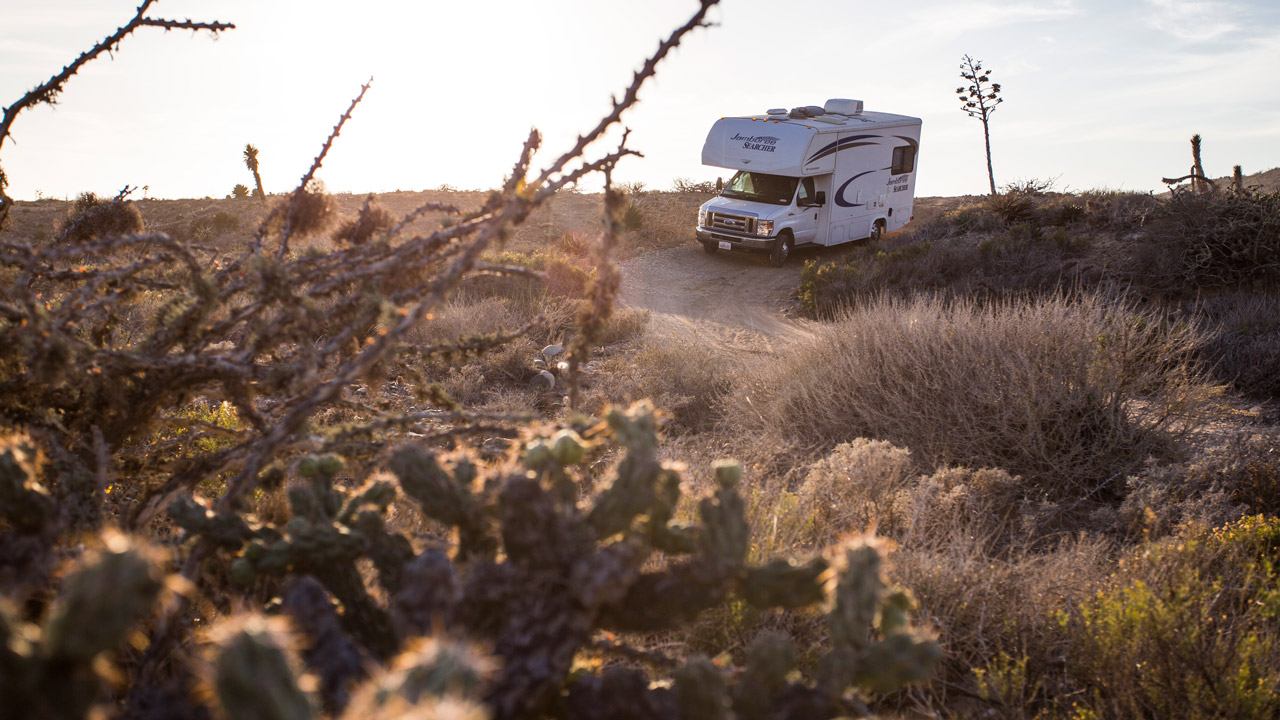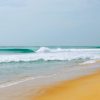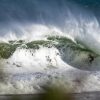While ostensibly empty, the desert here is never devoid of life. Tough, spiky, drought resistant life. Cacti run the show, cacti of every possible shape and size. And within this parched region, there are a great variety of landscapes.
Undulating plains of dust, plateaus dominated by single agave species, and mountainous slopes punctuated with the bizarre, Dr Suess type cirio trees, creating a truly alien impression.
There are also bouldered zones, transformed into stunning compositions by artfully placed verticals, in the form of the archetypal Saguaro cacti, growing majestically amongst the house-sized boulders. They look like some sensitive giant’s lovingly created rock garden.
After a day and night of desert driving, local guide Vicente had delivered us to a long right point break, and morning revealed mellow 4 footers running lazily down a cobblestone peninsula. I thought the waves looked fun, in a fishy sort of way, but I knew the surfers wouldn’t think much of them. As a road dust rinse however, they did the job.
Our first camp resembled a shantytown. A big RV was the community hall, and scruffy tents formed brave little suburbs around it. (Dillon Perillo’s crinkled, sad effort was definitely one of the slums). It took awhile to settle into any sort of order with cooking and the like; with 8 people and a huge pile of miscellaneous stuff, you need military type discipline to organise even basic things like meals. Since we were far from disciplined – I wouldn’t quite call us useless – we initially resorted to snacks, fruit and other easy pickings as a kind of buffer before we had to face any actual cooking.
On the second afternoon we stumbled onto a deserted little bluff that held a nice looking right-hander, reeling off towards a rocky coastline that was all rich, golden earth tones in the late warm sunlight.
The coastal terrain was reminiscent of Streaky Bay in South Australia, and I wondered what swam in the ocean here. It didn’t have a sharky vibe, but who knows? Vicente hadn’t been aware of this wave, and no one could say whether it had been surfed before. It was an inviting set up, and the boys flared out there in the last of the day’s rays, Louie Hynd’s patented backhand fin blows lighting up in showers of gold sparks before sunset turned them to muted purples.
The cool water temperature demanded steamers, and the land wasn’t far behind once the sun had set. That is typical of a desert environment, which only adds to the demands of surviving in arid zones. This fluctuating temperature had us going from fully fleeced, rugged up beanie wearers at night, competing for the least smokey campfire position, to board short wearing, dehydrated rats during the heat of the day. It was relentless.
During our ongoing surf reconnaissance, we spotted a perfect, hollow little right hander. The surf was tiny on that first sighting, but the potential was sound.
The unsettlingly regular appearance of the bones and bodies of better adapted species than us, more worthy candidates than us, remind us constantly of our artificial and interim status of survival. We stumble our way around, an ignorant approach propped up by our machines and the knowledge that we are but brief visitors. Long term success here is a smarter, more elegant ask.
This place grows on us as the days roll by. Almost imperceptibly, its subtle beauty emerges from our initial impressions of a dusty wasteland. It has an understated magic that gradually seeps into you like a soothing balm. There’s an increasing appreciation of the pared back existence, all superfluous frills long since burned away by the sun and the stone and the sharp and spiky edges.
But it is mesmerising, too. There are occasional, spectacular groves of cacti holding dozens of different species, like thorny rainforests. The diversity in these is astonishing: tall, fat, flat, spiral, spherical, every shade of green and every gauge of thorn, from hair-like to daggers as thick as sharpened pencils. They are punctuated with saturated, multi-coloured blossoms, and look like the work of a sinister artist with a malignant sense of humour, but a brilliant eye for design.
In one of these seemingly inaccessible gardens I noticed a beautiful little hummingbird, barely the size of a moth, buzzing around and feeding nonchalantly from the seemingly impregnable flowers. His skillful control and delicate hovering gave him access to even the most thornily recessed blooms, a master of adaptation to rival, and even outwit, the recurring hazards of this ecosystem.
In ancient times, the campfire was the focus of a family’s attention, before radio, television and all the rest of the electronic chewing gum options lobotomised our social brains. Fire was the original evening entertainment, a crackling and non-verbal entity that elicited conversation rather than discouraged it, and in between anecdotes and jokes it is an ever changing, hypnotic oracle.
Some of the campfire story telling was pretty hectic. Eight males in the wilderness will always get ribald and raucous, and unfortunately the best stories must remain untold, or at least anonymous. One, featuring a threesome and a dancing, in-situ tapeworm who was apparently intoxicated by a psychotropic alkaloid and acting in a very un-tapeworm like way, will probably not make it to print. It did however cause some of us to almost choke on our beers through sheer hilarity and laughter induced semi-asphyxia.
The waves here feel as protected by the filter of distance, the harshness of travel, the isolation and inaccessibility of the landscape, as the wise cacti are by their spines. And, too, some of the line ups that looked so nice from afar turned out to be not so great up close, yet another subtle gambit in this intriguing and demanding game of desert chess.
The swell had kicked a bit overnight, and seemed to still be on the rise. I was delighted at not knowing what was coming at all.
The lack of phone reception or any other communication had been a godsend in my eyes; we were supposed to be on the Search, and it seemed like better sport to be truly on our own, making decisions based on what we saw and felt, not based on some Internet swell guru directing us like imbeciles to go here or there. That seems more like following than Searching.
And then the waves turned on! Rory the videographer had disappeared again, as was his way. He would completely vanish within minutes of us checking anywhere. We’d stop, start to check a break, and before you knew it he would be on top of some distant mountain, his tripod already set up as he ripped into another clip. I began to suspect he could teleport himself, because at times he covered hundreds of metres in about 4 seconds. He is a tricky little bastard, and his work ethic is amazing.
The sets began to fire in, and the session would have been close to all time if there’d been a touch more size. I still thought it looked incredibly fun, but I had to concede it was definitely a bit of an: ‘If only’ moment.
In the afterglow of this surf, some genius suggested we go and have a look at another point, which had showed potential a few days prior. On that day, it had only been about 2 foot, but long, clean walls arced into a beautiful stony cove dotted with big green agaves.
It was a good hour’s drive, but with quenching road beers and time to cruise we moseyed on down there in the late afternoon, arriving near sunset to find it maxed out and lacking its previous mojo. Having driven out along the beach to the cove, we watched for a while, decided to head back to our current camping site, and then the walls closed in.
Getting bogged is just one of the things people do down here. They get stuck, they run out of petrol, food, coffee or beer … what’s the other one? Oh yeah, they die… – Dillon Perillo
The huge F350 hit a seam of hidden clay and sunk to the chassis in about 4 seconds. What we’d thought was easy sand had concealed the treacherous clay, but with spinning wheels we could now see it was worse than quicksand. The car was close to the surf, and with an incoming tide only about halfway up, and the sun halfway down, things looked grim.
We began to go through all the standard feeble procedures: air out of the tyres; everyone pushing; digging around the wheels. It was worse than useless. The tyres were spinning in baths of pure, wet clay, the heavy vehicle was utterly bottomed out, and waves were beginning to wash up past the doors. Help was a world away.
‘Oh well’, I thought, a bit disloyally, ‘It’ll make for a good story, and it’s only an insured hire car’. I started taking some photos while the others kept busy at a task as insurmountable as hitting the moon with a slingshot. At this point Dillon remembered seeing another big 4WD and caravan on the track on our way in. He carefully backed our other, smaller 4WD off the beach and soon returned with Tony. Poor, dear Tony.
From British Columbia, Tony is about 70, and had been quietly minding his own business when he was roped into our nightmare. He offered to try and pull us out with his powerful vehicle, and within seconds he was bogged, too. The dynamic of the situation changed in an instant. Instead of a crew of self-destructing twits, splashing around in the mud with our oversized Tonka toys, we were suddenly racked with the guilt of this poor guy’s life being ruined. With his only lifeline to the outside world sitting in an increasingly rising shore break of foam and surf, the sight of him, bad back and all, feebly trying to dig around his sunken tyres and $50,000 vehicle was heartbreaking. The feeling of helplessness was overwhelming. I could just make out the silhouette of Noah down there in the near darkness, trying to help him.
“Getting bogged is just one of the things people do down here. They get stuck, they run out of petrol, food, coffee or beer … what’s the other one? Oh yeah, they die. For me, our truck was a rental, so I was happy to just leave it in the surf and move on, let the locals salvage some parts,” Dillon said drily. “We happened to bring a helpless old man into it though, and managed to help him get his truck stuck too.”
What could we do? Chimpsy and Vicente drove off in our little 4WD, in some faint hope of finding a distant town with tow trucks and winches and bringing them back here … it was hopeless. The tide kept coming in.
A couple of hours later, Chimpsy and Vicente returned with reinforcements! Before committing to find help from afar, they’d stopped in out of desperation at our latest camping spot, an hour down the road, where there had been some other campers. Incredibly, they turned out to be total ‘can do’ types, with big car jacks and chains and ridiculously positive attitudes. They looked like they’d just come from MacGyver auditions. They had shovels, lights, and plans, and orders to shout at us, and we did everything they told us to. We dug and battled and crawled in the mud, and endured waves washing halfway up the cars, and motivated by Tony’s predicament we worked like maniacs. It took until about 1am, but finally both cars were free and clear. The look on Tony’s face as he drove off, mobile again, made life seem very special indeed. We could now leave here not only alive, but with our guilt appeased. It felt like time to go home.
We’d found a bit of surf, but discovered a lot about ourselves.
The extremes of that environment mean that only the most perfect adaptations will survive, and our own survival was due more to the brevity of our exposure than any real skills. With our clumsy negotiation of that scorched place, we paled into insignificance compared to those who have truly paid their dues of adaptation.
As an analogy for our lives, our short stint in the desert was appropriate. As in life, all we could do was marvel at the rugged beauty, the stark and surreal country that was ours to enjoy for the briefest time, before getting turfed out like the temporary lodgers we were. In geological time, our residence on earth is similarly brief, as we are summoned from comet dust like lottery winners to cling as long as we can to the beauty of life. The best we can do with those winning tickets is to make it a dance, as artful and elegant as possible. Like that clever hummingbird, who fluttered and finessed his way between the spines, so must we read between the lines. Burn bright like the incandescent beings that we are, before taking our bows and making our dignified retreat into the ether, back to raw materials ready for the next guest on this wonderful planet.


















































